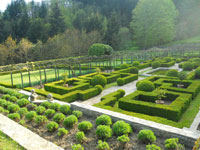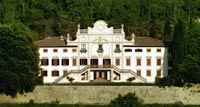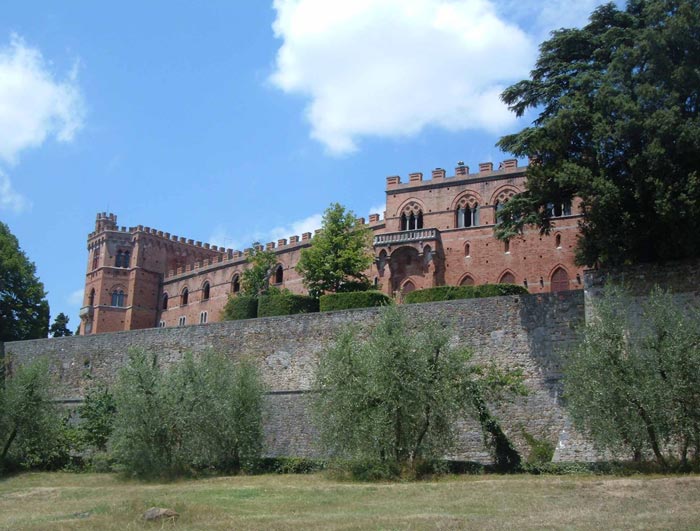 |
Castello di Brolio
|
Gaiole in Chianti |
First mention of the Gaiole territory comes from 1086 in an act of donation from the nearby Abbey of Coltibuono. However, it was only at the end of the 12 C that the village of Gaiole began to develop on the road which runs from Valdarno to Chianti, as a place of exchange for the nearby castles. Via Ricasoli, in the town center, is still the daily location of a lively, picturesque market. |
| Badia di Coltibuono is located in the Chianti zone of Tuscany near the town of Gaiole in Chianti. This monastery, founded in 1051, was owned by the Vallumbrosan order of Benedictine monks until 1810. When Tuscany was under Napoleonic rule, the monks were forced to leave Coltibuono and the monastery was deconsecrated and bought by the Stucchi-Prinetti family. Badia a Coltibuono has been well-preserved and there are guided tours of the 11th-century Romanesque monastery, the chapel and the italianate garden. The Badia a Coltibuono estate was founded by Vallombrosan monks in the 11th century and immediately became a center for wine production. Over the centuries, the monks of Coltibuono built up their landholdings to several hundred hectares, but this was all lost during the secularisation of the monastery in 1810, when Tuscany was under the rule of Napoleon. The estate was sold by lottery to Guido Guintini, whose descendants continue to run the winery today. |
||
| Parish Church of Santa Maria a Spaltenna |
||
| Castello di Spaltenna is located in Gaiole in Chianti, in the heart of the Chianti Classico wine region. This church alike the similar churches of San Giusto in Salcio, San Polo in Rosso, San Marcellino and San Vincenti, represents a rural settling dating back to the Romans. All those parish churches shared the same plan with three naves divided by quadrangular cross-section pillars and ending with a semi-circular apse.As you enter into the courtyard of Castello di Spaltenna you pass the entrance of Pieve di Spaltenna (Santa Maria di Spaltenna), a small Romanesque church dating back to the first half of the 12th century. Spaltenna was once a medieval monastery connected to the Pieve. The restaurant Il Pievano, run by Davide Canella, is situated at Castello di Spaltenna. The restaurant is open every night and consists of two indoor halls - Sala dei Papi and Sala degli Arazzi- and of the cloister near the parish Church.
|
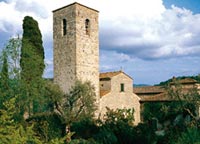 La Pieve di Santa Maria a Spaltenna |
|
| The Castello di Brolio rises in the centre of the Sienese Chianti area, at approximately half way between Castelnuovo Berardenga and Gaiole in Chianti. Brolio castle is strongly connected to the Ricasoli Firidolfi family, who were invested as lords of Brolio by Frederick Barbarossa in 1167. Today Brolio resembles no longer a manor house, but a Neo Gothic Villa, as a result of works carried out in 1861 for Baron Bettino Ricasoli. Although the castle is private, it is open for visits. And it is still possible to complete the walk of the ramparts, from which we one can have splendid sights on the Chianti region. Address: 53013 Gaiole in Chianti, Siena | www.ricasoli.it |
||
| Castle of Meleto The powerful structure of Meleto Castle rises on a gentle hill, in the heart of the Chianti Classico region, a short distance from the border between the old republics of Florence and Siena. The origin of Meleto was in the 11th century, as a possession of the monks of the near Coltibuono Abbey. Subsequently it has marked the history of one of the most important families of the Chianti area, the Ricasoli Firidolfi, who have embellished and modified its medioeval structure over the centuries. Today the massive fortification of the fifteenth century are still visible: the imposing towers built with a cylindrical structure to avoid the shots of the artillery, but also the distinguished grace of the eighteenth century villa. |
||
| San Giusto in Salcio |
||
| Situated in the municipality of Gaiole in Chianti, the ancient historic church of San Giusto in Salcio is already recorded in a document from the year 1018 originating from the archive of the Castello di Brolio, although what we see today is fruit of the restoration carried out in the late twenties. Only a part of the facade, the central apse and the lower parts of the external wall facing of the parish church are original, while all the rest, including the belltower, is the result of the restoration extending over the entire side where the house stands. The church has maintained the basilica-style three-naved layout, with the arches supported on quadrangular pillars without any real capital, and with three apses and a roof formed of trusses in wood and terracotta. The entire church, completely bare apart from a modern wooden crucifix, an exceptional work by the English sculptor Matthew Spender, has managed to preserve in the interior a superb austerity. The church houses a Madonna of Humility, an early sixteenth-century Florentine work from the Florentine school of Ghirlandaio. |
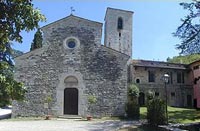 |
|
From the middle of Gaiole, towards east in direction of Valdarno, you find on the right the ruined castle of Montegrossi. |
||
| Pieve of San Marcellino, of medieval origin. It was mostly rebuilt in the 14th century. |
||
Castello di San Polo Rosso - The Pieve of San Polo Rosso, dating from the 12th century. It is now part of a 14th century defensive structure. The interior has a nave with two aisles and an apse. La chiesa di San Lorenzo a Ama si trova nel comune di Gaiole in Chianti ed è situata sul poggio di fronte alla Pieve di San Polo in Rosso. After taking, a bit further on, the road to the left and passing by Poggio San Polo, you descend to S. Polo in Rosso, a parish church recorded since 1070 in the maps of Coltibuono and conferred on the bishop of Fiesole in 1102 by Pasquale II. Although connected to the Abbey of Berardenga, it was under the protection of the Ricasoli family, who fortified it from the 14 C and made it an important strongpoint of the Florence defensive system. In 1478 it was occupied by the Sienese who, however, managed to keep it for only few years. The stone church has three naves. The left nave, which is raised up, has been crenellated and its vaults are covered in fourteenth-century frescoes. Next to the church, the fortified complex has several embrasures and the remains of machicolations. It also has two round towers at the corners, with scarp walls. |
||
| The Pieve of San Bartolomeo a Vertine (11th century) was once home of an early work by Simone Martini and a triptych by Bicci di Lorenzo, now in the Siena Pinacoteca. The pieve has some fragmentary medieval frescoes. |
||
| Pieve of San Vincenti. | ||
The Barbischio Castle overlooks the town of Gaiole in Chianti. Together with the near Montegrossi, Vertine and Meleto the castle belonged to the Florentine defenses of this area of Chianti, on the borderline with the territories of Siena. The principal function of Barbischio was, thanks to its tall watch tower, to be used as outpost. |
||
| Villa Vistarenni |
||
| The 16th century Villa Vistarenni dominates it from a hilltop 500 m above sea level. Vistarenni, that stems from Fisterinne, Etruscan name that means “good view”, was a small, fortified settlement that still existed in the year 1000 in the site where the villa stands nowadays. In 1852 the whole Pianigiani property was sold to the Prince Ferdinando Strozzi and was managed for about 40 years by this aristocratic Florentine family whose coat-of-arms can still be seen in some parts of the manor house of Vistarenni. Art in Florence | The Strozzi Family |
||
|
Gaiole in Chianti borders the following municipalities: Bucine, Castelnuovo Berardenga, Cavriglia, Montevarchi, Radda in Chianti. |
||
| Gaiole - Meleto walk |
||
| This walk is set in the heart of Chianti and the Chianti Classico wine-growing area. The route has all the ingredients for a typical Chianti walk. It starts in a stone-paved piazza, passes a 10th-century church, a castle involved in the wars between Siena and Florence, and a medieval tower house. [read more] |
||

